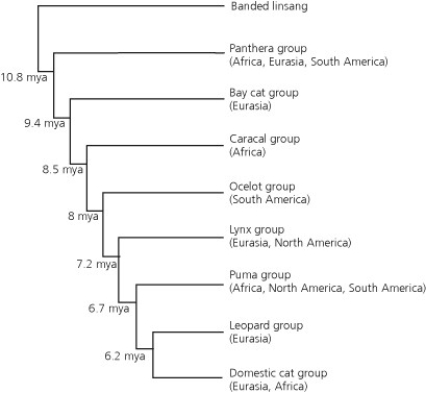Multiple Choice
The family Felidae (cats) is distributed across Africa, Eurasia, North America, and South America and is hypothesized to have eight major lineages (Panthera, bay cat, caracal, ocelot, lynx, puma, leopard, and domestic cat groups) as shown in this phylogenetic tree, constructed from DNA sequences. Scientists used a molecular clock and fossil evidence to date the divergence of each group. The dates of divergence are provided in the accompanying figure.

-According to the phylogenetic tree, what is the best explanation for why members of the Felidae are found on nearly all the major continents?
A) The common ancestor of the Felidae evolved on Pangaea.
B) Divergence and migration occurred multiple times, in multiple locations.
C) Species selection for fast predators was common on most continents.
D) The Felidae diversified in the Mesozoic, when the Earth's continents were still close together.
Correct Answer:

Verified
Correct Answer:
Verified
Q26: Which highly reactive gas was probably absent
Q27: Mass extinctions<br>A) remove many species, but they
Q28: The technique called radiometric dating is based
Q29: The three-domain system<br>A) no longer recognizes eukaryotes
Q30: Biologists are studying two species whose DNA
Q32: In mammals, the presence of four limbs
Q33: The 14C:12C ratio can be used to
Q34: The family Felidae (cats) is distributed across
Q35: A systematist includes a lizard in a
Q36: It is estimated that the modern continents